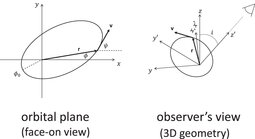Anonymous
08/21/2023 (Mon) 01:35
[Preview]
No.47
del

Smoking-gun evidence for modified gravity at low acceleration from Gaia observations of wide binary stars
A new study reports conclusive evidence for the breakdown of standard gravity in the low acceleration limit from a verifiable analysis of the orbital motions of long-period, widely separated, binary stars, usually referred to as wide binaries in astronomy and astrophysics.
The study carried out by Kyu-Hyun Chae, professor of physics and astronomy at Sejong University in Seoul, used up to 26,500 wide binaries within 650 light years (LY) observed by European Space Agency's Gaia space telescope. The study was published in the 1 August 2023 issue of the Astrophysical Journal.
For a key improvement over other studies Chae's study focused on calculating gravitational accelerations experienced by binary stars as a function of their separation or, equivalently the orbital period, by a Monte Carlo deprojection of observed sky-projected motions to the three-dimensional space.
Chae explains, "From the start it seemed clear to me that gravity could be most directly and efficiently tested by calculating accelerations because gravitational field itself is an acceleration. My recent research experiences with galactic rotation curves led me to this idea. Galactic disks and wide binaries share some similarity in their orbits, though wide binaries follow highly elongated orbits while hydrogen gas particles in a galactic disk follow nearly circular orbits."
Also, unlike other studies Chae calibrated the occurrence rate of hidden nested inner binaries at a benchmark acceleration.
The study finds that when two stars orbit around with each other with accelerations lower than about one nanometer per second squared start to deviate from the prediction by Newton's universal law of gravitation and Einstein's general relativity.
For accelerations lower than about 0.1 nanometer per second squared, the observed acceleration is about 30 to 40% higher than the Newton-Einstein prediction. The significance is very high meeting the conventional criteria of 5 sigma for a scientific discovery. In a sample of 20,000 wide binaries within a distance limit of 650 LY two independent acceleration bins respectively show deviations of over 5 sigma significance in the same direction.
Because the observed accelerations stronger than about 10 nanometer per second squared agree well with the Newton-Einstein prediction from the same analysis, the observed boost of accelerations at lower accelerations is a mystery. What is intriguing is that this breakdown of the Newton-Einstein theory at accelerations weaker than about one nanometer per second squared was suggested 40 years ago by theoretical physicist Mordehai Milgrom at the Weizmann Institute in Israel in a new theoretical framework called modified Newtonian dynamics (MOND) or Milgromian dynamics in current usage.
Message too long. Click here to view full text.